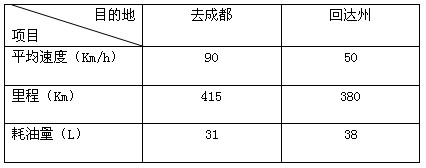节能是汽车性能的一个重要指标,但同一辆汽车每百公里的耗油量与行驶速度的快慢是否有关呢?端午节期间,小明乘坐爸爸的汽车由达州去成都,于是他决定借此机会对这一问题进行探究。他们去时走高速公路,回来时走318国道,得到了下表所示的数据。

(1)分析数据后,小明觉得这与他事先的猜想相吻合。你认为小明的猜想应该是: _________________________________________________________。
(2)若汽车在高速公路上行驶180km,求:
①汽车行驶的时间为多少?
②若该汽车发动机的功率为60kW,效率为30%,则汽车发动机所做的有用功为多少?
解:
(1)同一辆汽车,每百公里耗油量与行驶速度有关
(2)解:
①由V=St得汽车行驶时间t =S/V=180㎞÷90㎞/h=2h
②由P=Wt得汽车发动机做的总功W总=Pt=60×103W×2×3600S=4.32×108J
又∵η=W有/W总×100% ∴汽车发动机做的有用功W有= W总×η=4.32×108J×30%=1.296×108J。
